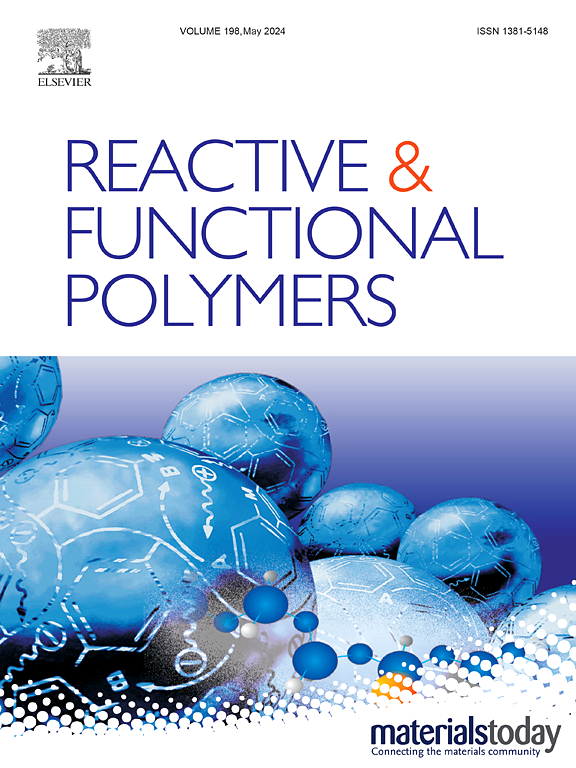Synthesis and characterization of metal affinity chromatography matrices functionalized with chlorophyll for bromelain purification
IF 4.5
3区 工程技术
Q1 CHEMISTRY, APPLIED
引用次数: 0
Abstract
Immobilized metal ion affinity chromatography (IMAC) is widely used in protein purification processes, and identifying new chelating agents is challenging for the field. This study proposed that chlorophyll is extracted from vegetables as a chelating agent in monolithic matrices for bromelain purification by IMAC. The adsorbents were synthesized by cryogelation and functionalized by the glutaraldehyde method by forming Schiff bases between the amino and carbonyl radicals in the chlorophyll structure. Commercial bromelain (Sigma, ≥ 3 protein units/mg ≥ 30 % protein) was used to experiment. The cryogels immobilized with copper ions stood out and presented an adsorptive capacity (q) of around 46.41 ± 2.93 mg/g. The matrix presented an average degree of expansion (ED) of 11.96 ± 2.66 kg/kg, swelling capacity (S) of 15.13 ± 2.32 L/kg, and porosity (around 85 %). The potential use demonstrated that it was possible to obtain a final enzymatic solution with twice the purity of the initial one, indicating that the adsorbent can still partially separate the enzyme of interest from the total protein fraction. The results demonstrated the similarity between the adsorbents functionalized with different chelating agents, indicating that chlorophyll did not alter the characteristics of the adsorbent and the potential as a chelating agent for application in affinity matrices for immobilized metals for protein purification.

叶绿素功能化金属亲和色谱纯化菠萝蛋白酶基质的合成与表征
固定化金属离子亲和色谱(IMAC)广泛应用于蛋白质纯化过程,而寻找新的螯合剂是该领域的一个挑战。本研究提出从蔬菜中提取叶绿素作为整体基质中的螯合剂,用IMAC法纯化菠萝蛋白酶。该吸附剂经冷冻合成,并通过叶绿素结构中氨基自由基和羰基自由基之间的席夫碱形成戊二醛功能化。实验采用市售菠萝蛋白酶(Sigma,≥3蛋白单位/mg≥30%蛋白)。铜离子固定化的冷冻剂吸附量(q)为46.41±2.93 mg/g。平均膨胀度(ED)为11.96±2.66 kg/kg,溶胀量(S)为15.13±2.32 L/kg,孔隙率(85%左右)。潜在的用途表明,最终的酶解溶液的纯度是初始酶解的两倍,这表明吸附剂仍然可以部分地将感兴趣的酶从总蛋白质部分中分离出来。结果表明,不同螯合剂功能化的吸附剂之间具有相似性,表明叶绿素不会改变吸附剂的特性,并且具有作为螯合剂应用于固定化金属蛋白纯化亲和基质的潜力。
本文章由计算机程序翻译,如有差异,请以英文原文为准。
求助全文
约1分钟内获得全文
求助全文
来源期刊

Reactive & Functional Polymers
工程技术-高分子科学
CiteScore
8.90
自引率
5.90%
发文量
259
审稿时长
27 days
期刊介绍:
Reactive & Functional Polymers provides a forum to disseminate original ideas, concepts and developments in the science and technology of polymers with functional groups, which impart specific chemical reactivity or physical, chemical, structural, biological, and pharmacological functionality. The scope covers organic polymers, acting for instance as reagents, catalysts, templates, ion-exchangers, selective sorbents, chelating or antimicrobial agents, drug carriers, sensors, membranes, and hydrogels. This also includes reactive cross-linkable prepolymers and high-performance thermosetting polymers, natural or degradable polymers, conducting polymers, and porous polymers.
Original research articles must contain thorough molecular and material characterization data on synthesis of the above polymers in combination with their applications. Applications include but are not limited to catalysis, water or effluent treatment, separations and recovery, electronics and information storage, energy conversion, encapsulation, or adhesion.
 求助内容:
求助内容: 应助结果提醒方式:
应助结果提醒方式:


